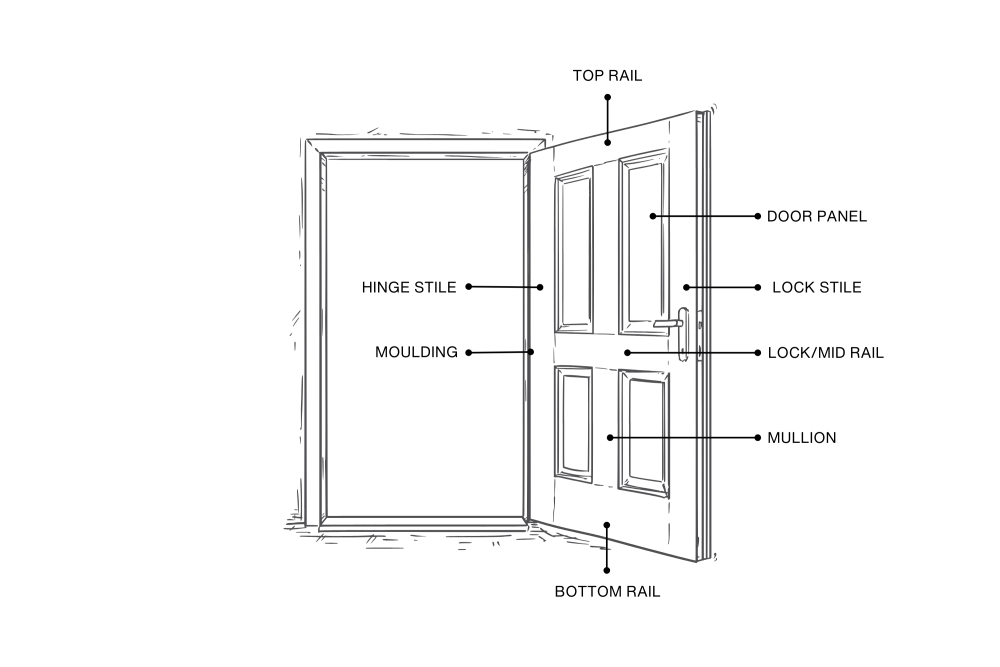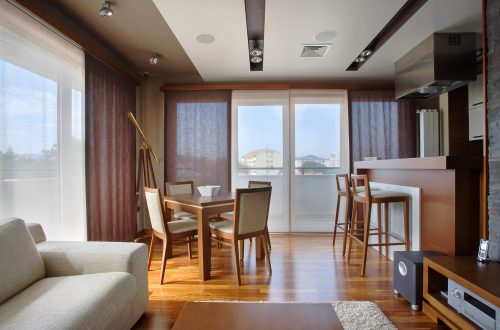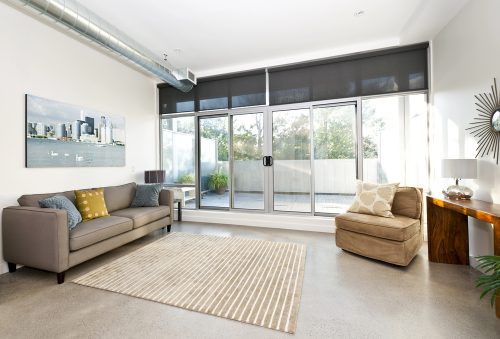Doors are integral to any building, providing security, privacy, and aesthetic appeal. Understanding the different parts of a door is essential, especially if you’re considering replacements or repairs. This guide will break down the anatomy of a door and its frame, covering the essential components, their functions, and names. Whether you’re a homeowner, builder, or renovator, knowing these parts will help you make informed decisions on your next door purchase.
Jump to a section:
- Parts of a Doorway
- Anatomy of a Door
- Parts of a Door Frame
- Door Hardware
- Common Materials for Door Frames
- How to Maintain Door Components
- FAQs About the Parts of a Door
Parts of a Doorway
A doorway is more than just an entry point; it’s a structural and aesthetic feature that enhances the functionality and appearance of your home. Here are the key components that make up a doorway:
Lintel
Definition: A structural horizontal beam located above the door.
Function: Supports the weight of the structure above the doorway and ensures stability.
Threshold
Definition: The flat or sloped piece at the base of the doorway.
Function: Acts as a barrier against water, drafts, and dirt while providing a durable surface for foot traffic.
Architrave
Definition: Decorative moulding that surrounds the doorway.
Function: Conceals the joint between the wall and the door frame, adding an elegant finish to the doorway.
Reveals
Definition: The vertical sides of the wall opening that connect to the door frame.
Function: Provides depth to the doorway and transitions the frame into the wall.
You may also like 15 Interior Door Styles & Types to Consider for Your Home
Are you in need of a new door for your home or business? Get in touch with our team today.
Anatomy of a Door
The door itself consists of several key components:
Door Panels
Definition: Door panels are the flat surface of the door that swings open or closed.
Function: Provides privacy, security, and a barrier between spaces.
Materials: Typically made from wood, glass, metal, or composite materials.
Stiles
Definition: Vertical sections on the sides of the door panel.
Types:
- Hinge Stile: The side where hinges are attached.
- Lock Stile: The side where the locking mechanism is installed.
Rails
Definition: Horizontal sections of the door panel.
Types:
- Top Rail: Located at the top of the door panel.
- Bottom Rail: Found at the bottom of the panel.
- Lock/Mid Rail: Positioned near the middle of the door to provide structural integrity.
Mullions
Definition: Vertical or horizontal bars between panels of the door.
Function: Adds structural support and visual division in panelled doors.
Glazing
Definition: Glass panels incorporated into a door.
Function: Allows light to pass through while maintaining security.
You may also like The Benefits of Installing a Double Glazed Front Door
Moulding
Definition: Decorative trim around the panels.
Function: Enhances the door’s appearance.
Knowing the anatomy of a door is crucial when choosing the right style for your home or business.

Parts of a Door Frame
The door frame holds the door in place and ensures it functions smoothly. Here are its key components:
Door Head (Header)
The head, or header, is the horizontal section at the top of the door frame. It spans the width of the door and provides structural support to the frame, helping it remain stable and aligned.
Jambs
The vertical sections on either side of the door frame are called the jambs. They include:
- Hinge jamb: The side where the hinges are installed.
- Strike jamb: The side that houses the strike plate and latch.
These components work together to hold the door securely in place and allow for smooth operation.
Door Sill
The sill forms the base of the door frame, connecting the vertical jambs. It acts as the foundation of the door and often includes a threshold to protect against drafts and water ingress.
Stop
The stop is a thin strip of material attached to the inner edges of the jambs and head. It prevents the door from swinging past the frame and ensures a snug fit when the door is closed.
Casing
The casing is the decorative trim that surrounds the door frame on both the interior and exterior. It conceals any gaps between the frame and the wall, offering a finished appearance.
Weatherstripping
Weatherstripping is a critical component that seals gaps between the door and the frame. It is typically made of rubber, foam, or silicone and is installed along the edges of the door jambs and head. The purpose of weatherstripping is to:
- Prevent air leaks.
- Keep out dust, moisture, and insects.
- Enhance energy efficiency by maintaining indoor temperatures.
You may also like Easy Ways to Weatherproof Exterior and Front Doors
Door Sweep
The door sweep is a flexible strip of material attached to the bottom edge of the door. It provides a seal between the door and the sill, preventing drafts, dirt, and moisture from entering. Door sweeps are often made of rubber or brush-like materials and are especially important for exterior doors.
Door Hardware
Door hardware encompasses the functional and decorative elements installed on a door to enhance its usability and security. These components play a vital role in how a door operates while contributing to its overall aesthetic. Here’s an overview of common door hardware elements:
Handles and Knobs
Door handles and knobs are the primary points of contact for opening and closing a door. They come in various styles and finishes, ranging from sleek modern designs to ornate traditional options, allowing you to match them to your décor.
- Lever Handles: Easier to operate, especially for people with limited mobility.
- Door Knob: A classic choice, often used for interior doors.
Locksets
Locksets provide security and privacy. They vary based on the level of protection required:
- Deadbolts: Offer enhanced security, typically used for exterior doors.
- Door Latch Locks: Commonly found on interior doors, providing basic privacy.
- Smart Locks: Use digital codes or mobile apps for keyless entry.
Hinges
Hinges are the mechanical elements that attach the door to the frame, allowing it to swing open and closed. The type of hinge depends on the door’s function and weight:
- Butt Hinges: The most common type, used for standard doors.
- Ball Bearing Hinges: Designed for heavier doors, offering smoother operation.
- Concealed Hinges: Hidden within the door and frame for a streamlined look.
Door Closers
Door closers are devices that automatically close the door after it is opened. They are commonly used in commercial buildings but can also be installed in homes for convenience and security.
- Surface-Mounted Closers: Installed on the surface of the door or frame.
- Concealed Closers: Hidden within the door for a cleaner appearance.
Strike Plates and Latches
The strike plate is a metal piece attached to the door frame where the latch or bolt locks into place. Together with the latch, it keeps the door securely closed.
Peepholes and Viewers
Peepholes or door viewers allow you to see who is outside without opening the door, providing an additional layer of security for exterior doors.
Door Stops
Door stops prevent the door from swinging too far and damaging walls or nearby furniture. They can be wall-mounted, floor-mounted, or hinge-mounted.
Kick Plates
Kick plates are protective metal or plastic panels installed at the bottom of the door to prevent scuffing and damage from regular use, especially in high-traffic areas.
Handlesets
Handlesets combine an exterior handle with a locking mechanism, typically used for front doors. They add a sophisticated look and come in various designs to suit different architectural styles.
Common Materials for Door Frames
The material used for the door frame can significantly affect its durability and maintenance requirements. Here are some popular options:
- Timber: A classic choice for its natural look and versatility.
- uPVC: Durable and low-maintenance, ideal for modern homes.
- Metal: Offers superior strength and is often used in industrial or security applications.
You may also like Front Door Style Guide: 8 Popular Types of Front Doors
How to Maintain Door Components
Proper maintenance of door and frame components can extend their lifespan and ensure smooth operation. Here are some tips:
- Lubricate hinges: Apply oil regularly to prevent squeaking.
- Inspect seals: Check weatherstripping for wear and replace if necessary.
- Clean panels: Use appropriate cleaners for the door material to maintain its finish.
- Tighten screws: Ensure hinges and handles are secure to avoid wobbling.
Find Your Next Door at Perth Window and Door Replacement Company
Doors are more than just functional elements of your home—they’re a vital part of its design and security. Understanding the parts of a doorway, door frame components, and door anatomy will help you maintain and upgrade your doors effectively.
At Perth Window and Door Replacement Company, we specialise in providing high-quality door solutions tailored to your needs. Whether you’re upgrading a single door or an entire property, our team is here to help. Contact us today to discuss your next door project.
<
FAQs About the Parts of a Door
The main parts include the door panel, stiles, rails, mullions, glazing and moulding. Each component plays a unique role in the door’s function and appearance.
A door frame consists of the head, jambs, sill, stop, weatherstripping, sweep and casing.
Understanding the anatomy of a door helps with maintenance, repair, and replacement. It also aids in selecting the right design and material for your needs.
Stiles are the vertical sections of a door panel, while rails are horizontal. Together, they form the structural framework of the door.
The door stop prevents the door from swinging past the frame, ensuring it closes securely.
A threshold bridges the interior and exterior, protecting the doorway from drafts, water, and debris.
Yes, components like door hinges, locks, or weatherstripping can be replaced individually without changing the entire door.
Consider the door’s weight, size, and usage. Materials like timber, metal, or uPVC are common options depending on aesthetic and functional needs.
A door jamb is a specific section of the door frame, whereas the door frame refers to the entire structure that supports the door. The door jamb includes the vertical components on either side of the door (side jambs) and the horizontal component at the top (head jamb). These jambs work together to form the core framework that holds the door in place. The door frame, on the other hand, encompasses all the structural parts, including the jambs, mullions, and other supporting elements.



